You Can Thank This Forgotten 19th Century Novel For the Christmas Prince Movie Genre
In Depth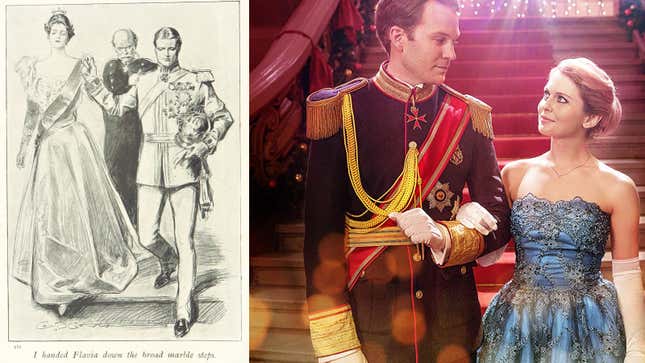

Are you racking your brain to figure out where on earth the various Christmas prince movies are set? It turns out they’re basically all the same place: Ruritania.
Ruritania isn’t real. It’s the late 19th-century invention of Anthony Hope, author of The Prisoner of Zenda, a swashbuckling adventure story about a man who goes on vacation and finds himself impersonating the king of Ruritania. The book was so popular that it effectively created an entire subgenre of adventure story. Books that followed included Beverley of Graustark, about an American girl who goes abroad to a small European country and bags herself a prince—long before Grace Kelly married into the royal family of Monaco. In other words, the various Christmas prince movies and their vague geographical coordinates are part of a long tradition of generically European pocket countries that stretches back more than a century, weaving through Genovia and ultimately culminating in Aldovia.
Fortunately, in January, Nicholas Daly, Professor of Modern English and American Literature at University College Dublin, is publishing a thorough cultural history of Ruritania and was willing to chat about the subgenre, some of the themes—which echo down into the modern versions—and, most importantly, where these made-up little principalities are supposed to be and why. Our conversation has been lightly edited and condensed.
JEZEBEL: What is Ruritania?
NICHOLAS DALY: The first real version we get in a novel called The Prisoner of Zenda, which appears in 1894, by Anthony Hope. It’s very much the swashbuckling adventure version of the story. Hero is on holidays in this small, semi-feudal country in Germany—a little statelet, effectively. For reasons too complicated to explain, he bears a very strong resemblance to the king who is about to be crowned. In order to thwart a coup, our hero gets drafted to replace the king, who has been drugged, then kidnapped.
He pretends to be the king for a while, and this works pretty well, except that he falls in love with the Princess Flavia, and he realizes that if this goes on long enough, he won’t be able to give up the throne. He’s become too involved. So he decides, you know, duty first, and he and the king’s supporters lay siege to the castle of Zenda and they rescue the king. This means that our hero, Rudolf Rassendyll, has to give up the throne, obviously, but also he has to give up Princess Flavia. They say their tortured goodbyes, he goes back to England, and she goes off to marry the real king. It’s a love story, it’s an adventure story, but it’s also a novel of renunciation, because they both have to give up love in the end for duty and honor and country.
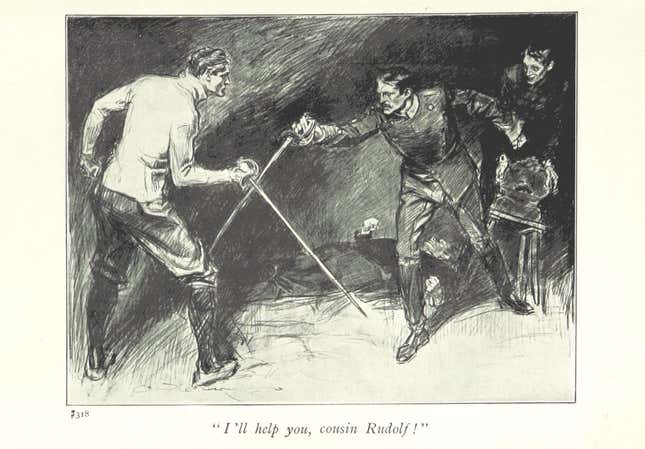
That’s your basic template. Anthony Hope goes back to that in 1898, with Rupert of Hentzau, which is effectively Return to Zenda. After that, you get many, many, many copycat versions—adventure novels set in all manner of Ruritanian places which are first of all German, and then as time goes by, they drift further east. They become more Balkan. Then you get other variations.
The most significant change to the formula is actually by an American author, George Barr McCutcheon. In 1904, he writes Beverly of Graustark, where we switch from the swashbuckling male hero to one where a female lead—our heroine, Beverly, a plucky American girl—is visiting friends in Graustark, which appears to be somewhere in Eastern Europe. We’re never quite sure where it is. There’s more confused identities. People think that she’s somebody else. She meets a prince in disguise, thinking that he’s somebody else, and eventually, she and the disguised prince fall in love and she becomes Princess Beverly of Graustark, an American princess. You can see that The Princess Diaries has a long, long tradition behind it!
The British and American versions probably mean slightly different things. The British version is a fantasy about chivalry and adventure surviving in the modern world. At a time when Britain itself is this major industrial power and a major imperial power, it’s a fantasy about going back in time, or going to a place where the past is curiously present, and where old-fashioned, manly virtues are still important. Men are men and women aren’t, you know, feminist New Women. They are instead beautiful and swooning types. The American one is slightly different, I think, though it is still very much about this little pocket country as being a playground in which various American virtues can come to the fore.
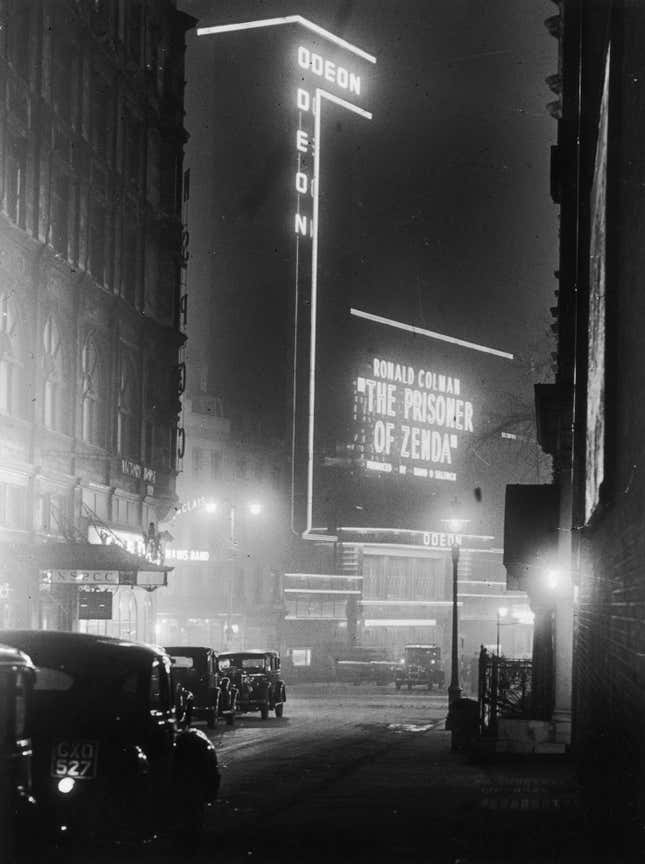
Obviously, thereafter you get many, many, many different wrinkles, but they all keep that idea. The Ruritanian territory is always small, it’s always slightly out of time, slightly backwards, kind of feudal or semi-feudal. There’s nearly always a lot of pageantry and court activity. There’s often skullduggery of various kinds, schemes against the throne which have to be foiled. And there’s always the romantic interest, so there’s a fairy tale aspect to all of them, where mostly ordinary people become kings, queens, princes, princesses, or they marry those people and thus are elevated. They’re not-so-thickly-disguised literary fairy tales, really, for a grown-up audience.
That’s really interesting because I figured there must be a thing that was older than Grace Kelly, that the Grace Kelly phenomenon must be tapping into some older American preoccupation, but I just couldn’t figure out what the thing was. Maybe it’s Beverly of Graustark.
I think Beverly of Graustark is definitely is a lingering memory. The Graustark novels are hugely successful in their day. George Barr McCutcheon is probably the best-paid American author of his time, or thereabouts anyway. Million-selling novel, and there’s a whole series of them, there are film versions, stage versions. There’s a Beverly of Graustark march, a musical version [laughs]. They kind of fade away after the silent film era, so that there are no sound era ones. By World War II, they’ve pretty much faded. I think there’s probably still some lingering memories in and around 1956, when Princess Grace comes along. There’s probably also some kind of hankering after the Wallis Simpson moment. At the time, the American newspapers were pretty much assuming Wallis Simpson was going to marry King Edward and become a queen. They had this other royal fantasy that never quite materialized, and I guess Princess Grace was a second time around, to some extent.
There’s often skullduggery of various kinds, you know, schemes against the throne which have to be foiled.
Even though The Prisoner of Zenda is your foundational version, I think the recent princess versions descend more from Beverly of Graustark, with the real Princess Grace story and things like that in there as well. And some princess culture.
You touched on this, but I’m curious to hear you talk about the sheer scale of this phenomenon. This is always so interesting to me, the way there will be these huge pop cultural phenomena, but then there’s some media break. How big was this, when people would have recognized this almost as a genre unto itself?
This is what interests me, too, is how things become popular, how they engineer popularity and how they lose popularity. How they fade, really. The Prisoner of Zenda has been the most successful in that respect, in that the film versions go right into the later 20th century that before disappearing. There hasn’t been a TV version since the ’80s. There hasn’t been a film version since the ’70s. The novels had been hugely popular, too, and the copycat versions. In and around 1905, 1906, there’s a review that suggests there’s now about a hundred of these Ruritanian stories doing the rounds, and they pretty much suggest that this formula is now exhausted. But it’s not! [laughs] It keeps going. It changes to suit the times in various ways. Whereas with Beverly of Graustark—he probably sold about a million and a half copies of the first Graustark novel, and Beverley of Graustark sold tons, as well. It was massively successful financially from the novels, even though he foolishly sold the copyright of the first one. He was very canny in his business dealings thereafter and made a lot of money from the various sequels.
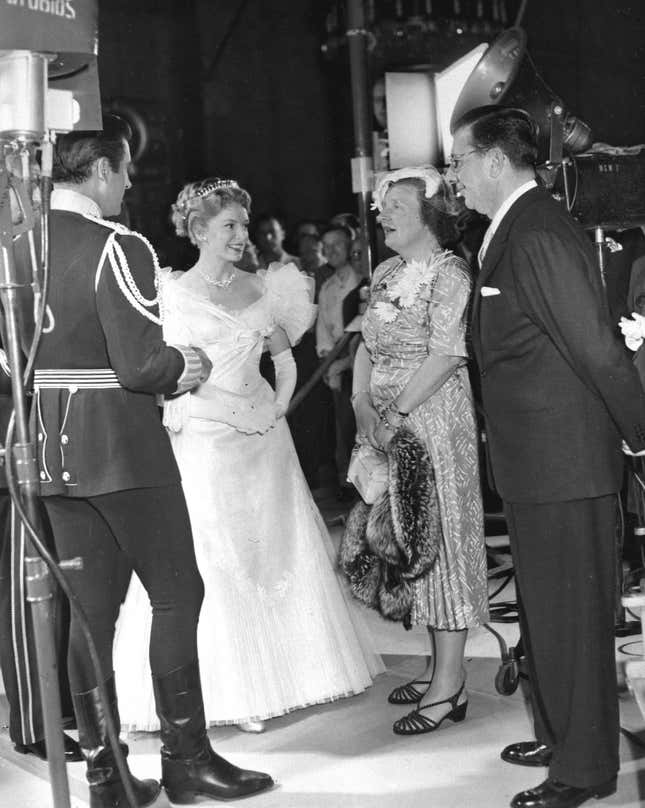
He dies in 1928, and at that point, there have been several film versions in the ’20s, there’d been earlier film versions, stage versions, and at this point probably even stock company versions. And it just never makes the leap into the sound era. They’re slightly more comic than the Anthony Hope Prisoner of Zenda versions, and I think maybe the comedy gets a bit dated. Maybe some of that fascination with old Europe begins to fade. I’m really not quite sure why they disappear so suddenly.
After World War II, if you start looking for Graustark, what you keep finding is a racehorse called Graustark, who was very successful. I think maybe World War II itself just washed away a lot of that of residual interest in a certain kind of old Europe. It just didn’t work anymore for people. I genuinely find it hard to explain why the Prisoner of Zenda version has lasted better—well, until recently. The very recent Christmas films have actually a lot more in common with Beverly of Graustark, as does the Princess Diaries.
I’m curious to talk about the cultural chord these books are striking. They’re sort of in opposition to dour, serious, and socially conscious drama, as well as the rise of the “New Woman,” right? They’re almost like a conservative pop-cultural turn?
That would be my two cents worth. In the 1890s, they’re actually backward-looking in some ways. Gender-wise, particularly in Prisoner of Zenda, it’s very much nostalgic for a pre-Oscar Wilde, pre-New Woman kind of a world, where men are men and women are womanly, or ladylike. They are very much part of an imperial culture. They don’t feature empire themselves, really, but the kind of heroism that’s celebrated is very much consonant with what you get in more obviously empire novels. Your H. Rider Haggard type, King Solomon’s Mines, things like that, tales of more exotic adventure. The logic of them is always that king and country is more important than anything else. The establishment must be protected at all costs, really, at all personal costs. You have to keep the kingdom going.
They are very much part of an imperial culture.
The Graustark ones are maybe a little different, but they’re not that dissimilar, really. They are still very conservative in their politics, even though in some ways Beverly of Graustark is a sort of accommodation with your New Woman type in that she’s actually quite an active heroine. She’s not a swooning beauty so much as a feisty type. She has some of that American frontier can-do spirit about her, even though she’s from Washington. There’s a sort of accommodation being made there with new ideas about gender. Though in the end, it’s all about marrying royalty and marrying into that world of ascribed status and prestige, so that you couldn’t really say that they’re celebrating democracy, in these novels. They’re pretty fiercely pro-royalty.
There’s that clash that you often get in later versions, the clash between the American spirit and protocols and red tape and courtly sedimented traditions, which is both loved for its color and quaintness, but also disliked because it’s a constraint. There’s a lot of that in The Princess Diaries, as you recall. “I’m a young American woman, I don’t want to be dressed up like a princess,” at the same time as being a princess is very attractive. It’s both constraining and engaging at the same time.
We touched on this, but where is Ruritania? It starts out in Germany and then it moves to the Balkans and then keeps moving. Where is it, and why is it there?Germany makes sense in the 1890s for Britain, because it’s sort of a mirror image. The British royal family is German, effectively. Victoria is descended from a German line, her husband is German, and for much of the 19th century, Britain and Prussia are allies. It’s really only in the warm-up for World War I that that begins to change and France becomes their new ally, having been their traditional foe. Some of the use of Germany is about that mirror image. Our hero in The Prisoner of Zenda has gone to a German school, for example, and speaks good German. This is why he is able to pass himself off as the king of Ruritania, which otherwise might be quite tricky! The language thing, of course, is one of the things that’s always skirted round in the Christmas movie versions. They all speak English. Everybody speaks English in Aldovia or Belgravia or wherever it might be.
You can see how Germany initially works. As that rivalry between Britain and Germany develops—and maybe the German formula has become a bit exhausted—they moved towards the Balkans as this quite lively part of the world in terms of geopolitics, where it’s possible to imagine there being a slightly behind the times little kingdom. It became pretty hard to imagine Germany having such places anymore after German unification when Germany was a big imperial power like Britain. It goes further east in trying to preserve the exoticness of the Ruritanian location. The Graustark version, we’re somewhere beyond Vienna, clearly. It jokes around about where it is exactly, and we’re actually told at one point that it’s not the Balkans, even though it appears to be. After World War I, the locations become a little harder to pin down, partly because Germany wasn’t considered a great land of fun anymore, and the Balkans likewise. But you still get these vaguely Eastern European settings in some of them.
You also get quite different ones. P.G. Wodehouse has a novel, The Prince and Betty, which is set in Mervo, which appears to be an island version of Monaco. The main industry is the casino. Even then, I think people are playing around with the location in interesting ways. You get more of that later on, after World War II Grand Fenwick in The Mouse That Roared, that appears to be somewhere between France and Switzerland. And then, of course, thanks to probably Princess Grace and the Grimaldis, you get that switch to a Monaco-type setting for The Princess Diaries and some of the similar fare.
It’s interesting that the Christmas Prince ones have gone back to a territory that seems to be more suitable for Christmas, really. You’ve got your Eastern European snow and sleds and roaring fires and stuff, which might be less attractive in Monaco. And of course, as you’ll have seen yourself, so many of them are actually filmed in Romania, because the Romanian film industry has really pushed Romania as a place for location shooting. So that one castle is in three or four different films.
I like the idea of setting a Hallmark Christmas movie at a casino, because so much of the Hallmark thing is the audience is quietly evangelical Americans, but interesting to a crossover audience. But they can’t really have too much to do with a casino.
That would not work, I think. Santa and gambling just don’t mix, really.
It does of course also keep their whiteness largely intact. They’re very European, these royal families. Though I’ve realized that I’ve gotten the ethnicity slightly wrong in my take on The Princess Switch. Vanessa Hudgens actually is partly Filipina by ancestry, I think. Maybe that’s one of the ones where they are trying to steer away from the absolute whiteness of the earlier ones, which are very much about WASPy looking women marrying even more WASPy looking, usually British actors. Nearly all the princes are played by Brits. Whereas the heroines have been slightly more varied. The odd Australian and New Zealander has made it in. Katie McGrath, in one of the first ones, is actually Irish. But that said, it is very Hallmarky and a certain version of middle America, I suppose, is what we’re being offered.
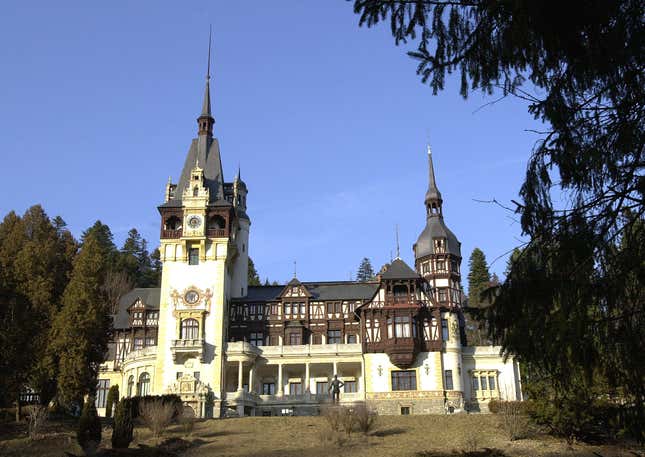
It is interesting to me that they’re filming in Romania, but in terms of the presentation, it does seem more like somewhere like Monaco, but without the gambling. This is somewhere in Eastern Europe, but there’s no sense of the long history of Eastern Europe. There’s no sense of the Soviets or the Ottomans. No, no, it’s somehow been Germans all the way back, despite the fact that literally we have access to the Black Sea for some reason. It’s so weird!
History has no place in these. At the same time, you know, it’s that weird fetishization of history and tradition and castles, at the same time that actual history swept away and not seen to be in any way relevant. I guess they’re the castles of the fairytales rather than the castles out of the medieval or feudal past. They’re curiously historyless.
Actually, it turns out that the much-used Peleș Castle is largely a 19th-century fantasy creation itself. It’s sort of a retrofitted castle, really, much of it built at the end of the 19th century. So it makes certain sort of sense. It’s like Romanian Disney Castle.
It’s that weird fetishization of history and tradition and castles, at the same time that actual history is just swept away and not seen to be in any way relevant.
It’s a fascination with feudalism that harkens back to an earlier fascination with feudalism—it’s very funny.
It’s the escalator of feudalism! It’s always somebody else’s past. Again, it doesn’t suggest much of an interest in democracy.